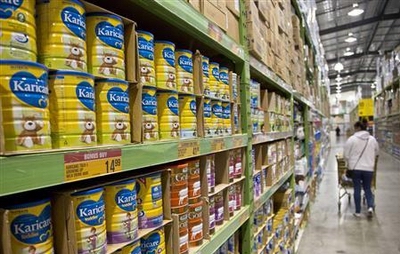
India's milk production is likely to rise almost 5 percent in the year to next March to 133 million tons, said R G Chandramogan, managing director of Hatsun Agro Products Ltd, one of the country's leading milk powder exporters.
Traditionally, most of that production stays at home as a protein staple for a population of 1.2 billion, but with domestic demand pegged at around 128 million tons, there should be more milk available to make skimmed milk powder (SMP) for export. The Indian government also usually restricts overseas sales to keep a lid on local prices.
But, with more milk powder, a weaker rupee currency and Chinese restrictions on using some New Zealand products in the wake of Fonterra's whey powder concentrate contamination scare, [ID:nL4N0G70HI] India expects its SMP exports to jump by more than half to 100,000 tons this year, said R.S. Sodhi, managing director of Gujarat Cooperative Milk Marketing Federation Ltd (GCMMF), India's top milk product exporter and owner of Amul, the nation's best-known milk and dairy products brand.
Referring to New Zealand's food safety issue, Sodhi said: "We don't have such a problem. This is a very good opportunity for India. Definitely our exports will rise this year."
Amul branded products won't be appearing in Chinese supermarkets just yet - Indian supplies will go to milk product makers who then use their own packaging. GCMMF expects to ship 25,000 tons of SMP this year - five times last year's levels.
"This year there is no (export) restriction and market conditions are better," said Sodhi.
Peak Season
Nearly 90 percent of China's $1.9 billion in milk powder imports last year originated in New Zealand. India's milk product exports are tiny in comparison - just $230 million last year, mainly to south Asian countries and the Middle East. India only felt comfortable enough with its domestic supplies to lift an SMP export ban in June 2012.
"We are heading towards the flush season, so there will be more milk available for SMP. We are getting good export orders for SMP," said Vinayak Patil, chairman of the Maharashtra State Cooperative Milk Federation. August marks the start of a 2-3 month peak milk production season in some Indian states.
Rising export prices are also boosting sales, especially with the rupee's weakness. The currency hit a record low of 61.80 to the dollar on Tuesday, and has lost a tenth of its value so far this year.
"SMP prices have risen more than 15 percent in six months in dollar terms," said an official at a Delhi-based co-operative dairy. "With the rupee depreciation," he added, "SMP exports are now lucrative for dairies."





